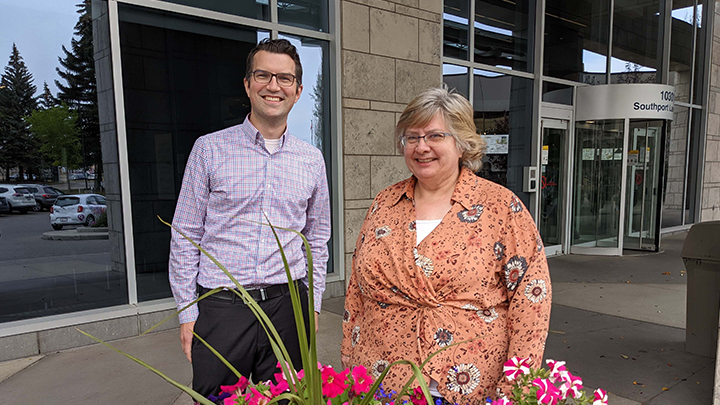
November 8, 2022

Health literacy consultants Vincent Terstappen and Shirley Chandler are on a mission to make healthcare knowledge more accessible through the use of plain language. They offer a goldmine of tips and resources for AHS staff, physicians and volunteers as well as oversee MyHealth.Alberta.ca, a trusted source of easy-to-understand information on health conditions, healthy living, medicines, tests and treatments. Photo supplied.
Story by Gregory Kennedy
Don’t ever doubt the value of plain language when it comes to healthcare.
Consider this bit of medical bafflegab: “Ingest two capsular units of acetylsalicylic acid and implement a vocal communication my way in the ante meridiem.”
If your doctor were to utter such words, you’d tell them to get the marbles out of their mouth, and try again with something simpler like: “Take two aspirins and call me in the morning.”
A passion for clarity and a love of language keep health literacy consultants Shirley Chandler, Vincent Terstappen and Heather Ball on their grammatical toes daily for Alberta Health Services. They’re the team who oversee content for MyHealth.Alberta.ca, the website Albertans rely upon as a trusted source of easy-to-understand information on health conditions, healthy living, medicines, tests and treatments.
“I love making things understandable and easier for people to read so that they know what's going on,” says Chandler. “I'm a Registered Nurse and I like finding ways to explain things better. It’s always been a passion of mine.
“I’ve experienced it myself, and I've also seen it in others, where you tell them something and they nod and say ‘yes’ or they sit there with this stone look on their face — and you know you haven't reached them. You know they don't get what you're saying.”
With a background in population health and communications, Terstappen says he believes presenting health information in a more understandable way not only preserves, but has the potential to improve the well-being of all Albertans.
“At MyHealth.Alberta.ca, we get lots of content from subject-matter experts across Alberta who work in, what some might call “the nuance”. They're so smart. They're so deep in their areas and we get this amazing health information from them.
“Then we take a look at it to say: ‘How can we present this in a more straightforward way that makes sense to someone who's just pulling this up to read on their smartphone in the middle of their busy day?”
According to the International Plain Language Federation: “A communication is in plain language if its wording, structure, and design are so clear that the intended audience can easily find what they need, understand what they find, and use that information.”
Plain language also advances AHS’ goal of providing Patient & Family Centred Care, which promotes the respect and dignity of the patient, the sharing of information in an affirming and useful way, collaboration, and empowers the patient to participate more in their healthcare journey.
“We want to give people some information they can take away and use,” adds Chandler. “When it comes to healthcare, you're not just trying to get a better deal on a car — your life is involved there.”
Keep a personal tone with an active voice to reach more readers, she suggests. Don’t tell people what they shouldn’t do, let them know what they can do, to keep healthy.
Bulleted lists with headings also allow people to skim and absorb information easier.
“By giving lots of subheadings, we’re organizing content in a flow that makes sense, and really supporting people to scan and browse,” says Terstappen, who adds that the question-and-answer format is also a tried-and-true way to reach the reader.
“We structure a lot of our health content as question-and-answer. For example, the question may be: ‘What should I do if I get this test result?’ The answer will begin: ‘If you get this test result, you should…’ This kind of language allows the reader to see themselves. When we edit, one of the big changes that we often make is to make sure we’re really speaking directly to the person, like Shirley says, in an active voice.”
Acronyms, jargon, medicalese and colloquialisms are also to be avoided, wherever possible.
“Not everybody was born and raised in the same type of household or culture,” says Chandler. “Diversity and inclusion, gender and culture sensitivity are huge in what we do - and it's becoming increasingly so.”
As the small but mighty health literacy team reaches out to others who share their passion, interest is growing in their work, and they’re winning over new converts to the joy of simplicity.
“A dream of ours is to develop a community of practice within Alberta Health Services for everybody who’s interested in plain language and health literacy. This dream is becoming a reality in that AHS has started an initiative to bring together various portfolios who support health literacy and who may be working in this area.”
Plain Language…
Five Things to Consider
Plain Language Tips
For more information, visit Plain Language Association International.